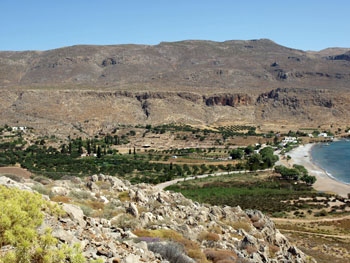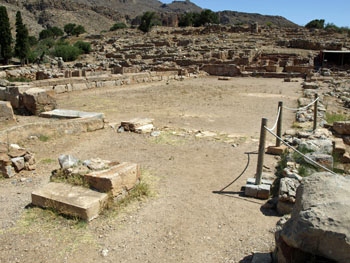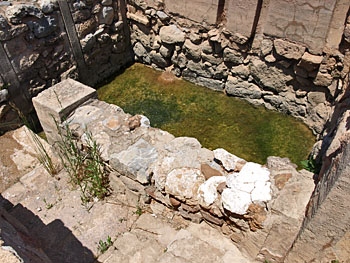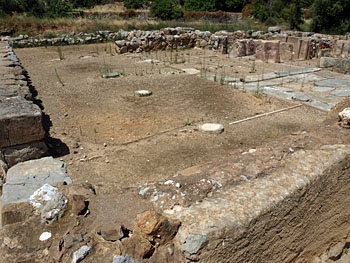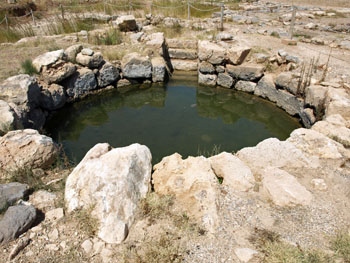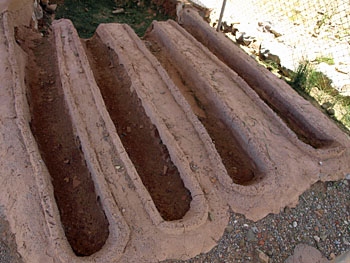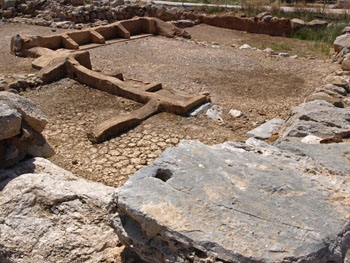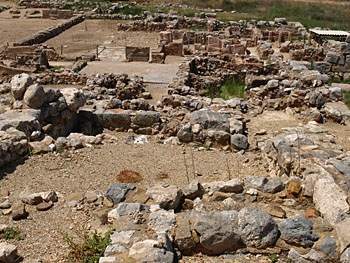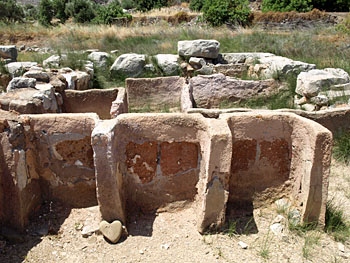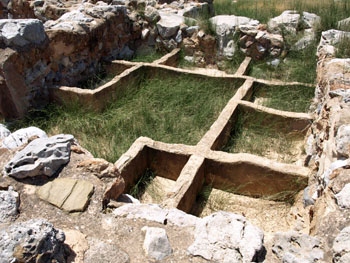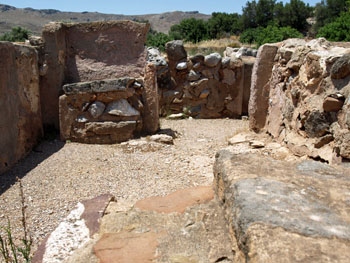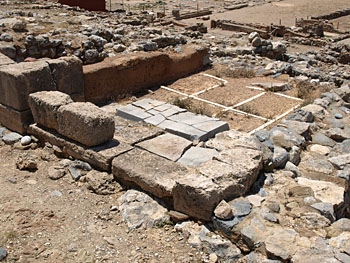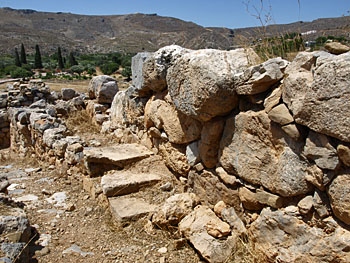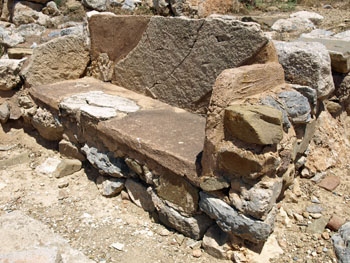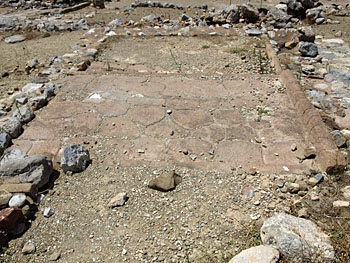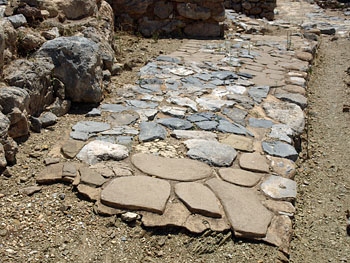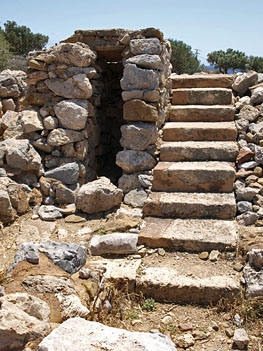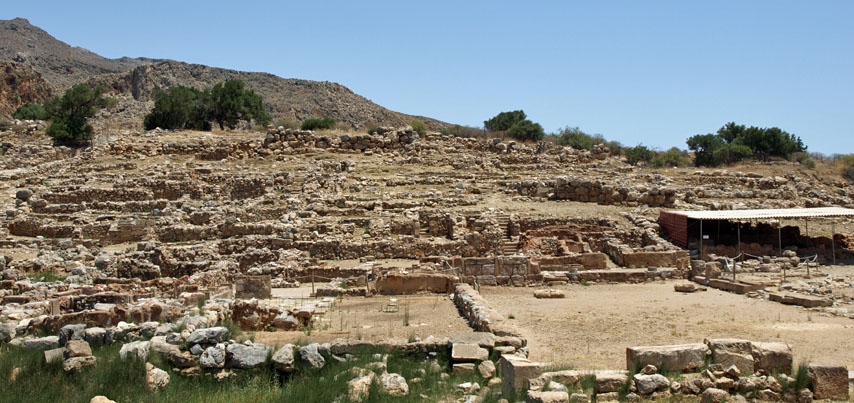
Location and excavations
The Palace of Zakros, the most isolated of all the Minoan Palaces, is located on the east coast of Crete, south of Palaikastro. Its position shelters it from the dangerously strong north winds that pass Cape Sidero on the northeast tip of Crete. It was the last of the major palaces to be discovered and is smaller than the other three at Knossos, Malia and Phaistos. The original excavations were begun by D.G. Howarth of the British School of Archaeology at Athens, and 12 houses in the town surrounding the Palace, whose existence remained unknown, were unearthed before the excavation was abandoned. Nikolaos Platon resumed the excavation in 1961 and was able to unearth a palace which had not been looted at the time of its destruction. The excavations have continued until the present day. The excavation represents one of the most important for Minoan archaeology since the Second World War, and the lateness of its discovery allowed it to be excavated using more modern and more scientific methods than those adopted in the excavation of the other Palaces some 60 years earlier.
Gateway to the East
The Palace of Zakros probably acted as the Minoan gateway to the east and this view is supported by various movable finds on the site which had come from the Middle East. In the West Wing an elephant tusk and six ox-hide ingots were found and Cananite jars were discovered near the well.
Like the other palaces, Zakros was rebuilt after the earthquake destruction of the old palaces. The second palace was built around 1600 BCE and finally destroyed around 1450 BCE, along with other centres of Minoan civilisation in Crete. Fortunately many artefacts were left in situ, probably due to the suddenness of the destruction. The palace covered 8,000 square metres, contained 150 rooms and had a Central Court measuring about 30 metres by 12 metres, considerably smaller than that of Knossos.
The North Wing
Both the town and the harbour lay to the north of the palace at Zakros. The harbour was most likely connected to the Palace by a road and the north east entrance (LXIX) formed the main, but not the only entrance to the palace complex. The passageway led directly into a large north east court (LXIII) from which it was possible to access the Central Court.
The fact that the main entrance was in the north east, close to the sea may mean that Zakros functioned more as a trading palace than one concerned with agricultural produce, although there was certainly fertile land in the immediate environs of the palace. Storage areas in the palace do not seem to have been used to store agricultural produce on the same scale as other palaces. Pottery, metal goods and textiles seems to have made up much of the goods stored here. It has been suggested by Malcolm Wiener that Zakros may have played a special role in relation to trade with the east as part of the wider palatial system in Minoan Crete.
At any rate, one consequence of having the town and harbour to the north and placing the main entrance in the north-east of the palace complex is that the facade of the West Wing did not play the important role here that it played at the other palaces, where it is considered to have been an interface with the town. In fact the stone blocks that comprise the west facade are altogether more rough and ready than the finely cut ashlar masonry forming the west facades of the other palaces. The West Court is also considerably smaller than those of the other palaces and its size was reduced even further by the building of an annexe to the West Wing which not only ran for one-third of the length of the west facade but also increased the width of the West Wing by a third, in doing so obscuring the original facade. The annexe contained nine shallow basins and a drainage system. The excavator, Platon, interpreted this as an industrial area used possibly for dyeing fabrics.
The North Wing contained a hypostyle hall (XXXII) which has been identified as a dining hall on the basis of identifying the adjoining area at the north east corner of the Central Court as kitchens (rooms L-LIV). Hitchcock suggests that the dining hall would have been on the upper floor and that workers from the town would have entered the hypostyle hall at ground level through a door at the north east end of the north wall. From there they would have been able to enter the kitchen area.
The buildings to the east of the kitchen area contain a lustral basin, now roofed over for protection, in which remains of frescos showing sacred objects like double axes and horns of consecration were found.
The West Wing
In contrast with the many access points to the East Wing at Zakros, there are only three points of access to the West Wing. One leads directly into the Minoan Hall at its northernmost point. A second passes through an area which has been identified as a pillar crypt (XXX) while immediately to the north of this area there is a corridor (XXXI). Both the corridor, which leads from the north-west corner of the Central court, and the pillar crypt open into a vestibule. From the vestibule it was possible to access different parts of the west wing -- the storage magazines in the northwest corner of the west wing (II-VIII), the administrative area centred on room XVI in the south west area and the ceremonial rooms (XXIV-XXIX) in the eastern part of the West Wing.
The central part of the West Wing facing the Central Court, known as the "Hall of Ceremonies" (XXVIII), is made up of a large Minoan Hall. Louise Hitchcock argues that it wouldn't actually have been used for ceremonial activities -- at least not ones involving large numbers of people -- as it could only be entered by one door in the north-east corner of the room. That is not to deny the importance of this room, which, according to Gessell, is the second largest complex of Minoan pier-and-door partition halls in Crete. Fresco remains were found here, together with cult objects which had presumably fallen from the floor above, as has been noticed so often at Minoan palaces. Among the finds were two rhyta. The first was the famous bull's head rhyton and the second showed a tripartite peak sanctuary.
The "Hall of Ceremonies" is in effect two rows of halls, one on the east and one on the west. Various interpretations have been offered for the function of this area including a room for ceremonial activities, a cult area and even a winter residential quarter, but essentially it is still not known what its actual purpose was.
To the West of the Minoan Hall is a Lustral Basin with an anteroom (XIV-XV). The role of these lustral basins has been disputed amongst scholars. Some believe that they were domestic bathrooms, especially when located adjacent to rooms which are considered to be some kind of royal apartment. On the other hand, many scholars argue that they have a purely religious function and that they were probably used for ritual cleansing. Certainly the presence of gypsum in many lustral basins would rule out large quantities of water being used in them as the gypsum would dissolve over time. Those who believe that the lustral basins were purely for ritual purposes argue that any ritual cleansing would have been done using water from jugs rather than filling the bottom of the basin with water.
The archive room (XVI) contained over a dozen Linear A tablets and could be reached either from the pillar crypt entrance or by entering the Minoan Hall and passing the Lustral Basin. A room on the southern end of the West Wing (XXV) was named "The Treasury of the Shrine" by Platon. Although the Shrine itself (XXIII) lies immediately north of the Treasury there is no direct access between the two rooms. In fact you have to pass through six different areas to get from one room to the other. The west wing shrine itself was a small room with two benches, and here various libation vases were found. The Treasury on the other hand contained a large number of important vessels like chalices and rhyta, including one of rock crystal and many of stone as well as bronze double axes. Since the room communicated much more easily with the Minoan Hall than with the Shrine, it could be argued that the Treasury was not linked to the Shrine at all but was the room where objects used in ritual activity were stored when not in use.
The East Wing
Platon, basing himself on Evans's view of Knossos, argued that the "royal apartments" were located in the East Wing of the Palace. A portico runs the whole length of the court on the east side and behind the portico Platon identified two Minoan Halls as the "Queen's Megaron" and, to the south, the larger "King's Megaron". In Platon's view, the royal bedrooms would have been on an upper floor. However no evidence was found in these rooms to suggest their use as a residential quarter.
In the East wing of the palace there area also number of water features that are not found at other palaces. Louise Hitchcock believes that the water features at Zakros might be linked to the economic function of the palace and religious practice on the site. Given the seeming importance of sea trade to the palace of Zakros, safety at sea would have been very important to its people. The first water feature is the "Unit of the Built Well" (XXXIX) in the south east corner of the east wing, close to a major workshop area. The water in the Built Well, which was most likely used by the workshops, was reached by steps leading down to a platform.
To the east of the Built Well lies The "Well of the Fountain" (LXX). This was a rectangular structure which was connected to the "Spring Chamber" (LXXI) immediately to its north under a stairwell to the upper floor. The Well could only be approached from outside the building. Fifteen steps led down into the well. Objects placed in both the Built Well and the Well of the Fountain included conical cups, dishes and olives and are considered to be offerings to a deity.
The final water feature is the largest, the "Cistern Room" (LXII), with its seven steps that descend to the floor of the cistern. The cistern was part of the palace complex and in fact lay immediately to the east of the "royal apartments" in its own court. The cistern was not covered with a roof although it may have been surrounded by a portico. Platon suggested two possible explanations for the cistern. It might have simply added a "picturesque element" to the palace or it might have been used by the palace elite for bathing. However it might instead have had a ceremonial or ritual function, although we shouldn't rule out the possibility of any of these water features having multiple functions including the practical and the ritualistic.
The South Wing
In the South Wing there was a major entrance to the palace through corridor XLIX, which could be approached outside the palace from both the east and the west. The corridor leads to the south west corner of the Central Court. While at Malia and Knossos the South Entrance was the main entrance to the Palace, this was not the case at Zakros where the south entrance lacks the architecture of procession and ceremony that is provided at Knossos by, for example, the Corridor of the Processions with its wall paintings.
Immediately to the right of the corridor, there was a block of workshops (XLII-XLVIII). Finds here include unworked stone, loom weights and sheets of metal. It is believed that this group of rooms included a faience workshop. This is a pottery technique which gives a glazed effect.
The town
The Palace was surrounded by the town, of which only a part has so far been excavated. The houses were often quite large, containing up to 30 rooms, with small storage rooms built around a large room with a bench and a central support. The houses were arranged in blocks and both olive oil and wine presses were found in the town. It seems that the town specialised in the production of wine which was exported to the Cyclades. It is almost certain that some of the town buildings were not houses, however, but buildings belonging to the palace.
In one such building Hogarth discovered 500 clay sealings with images of imaginary creatures. South of the harbour road a furnace was discovered which, judging by its size, must have been one of the most important in this part of the Mediterranean.
The site is very remote, and involves a long drive across fairly barren countryside, but the final drive down to the seashore and the setting of Zakros itself is spectacular. A few tavernas line the beach offering shade, food and drink after your time under the relentless sun.
The town


